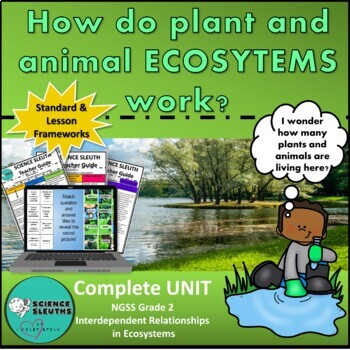Ecosystems STEM Unit NGSS Science Grade 2 - Science Sleuths - Print and Digital
- Google Drive™ folder

Also included in
- Second Grade NGSS Science curriculum for the entire year!Use Science Sleuths to teach NGSS Earth's Systems: Process that Shape Earth, Structure and Properties of Matter, and Ecosystems: Interdependent Relationships in Ecosystems for second grade. Includes a complete integrated unit with teacher staPrice $24.00Original Price $31.00Save $7.00
Description
BOOM! Science Sleuths has arrived!
Instruction for day and night science standards will never be the same again when your students become science sleuths and earn achievement badges!
Use Science Sleuths to teach Ecosystems: Interdependent Relationships in Ecosystems for second grade NGSS standards. Includes a complete integrated unit with teacher standard practices in the disciplinary core ideas, science and engineering practices, and crosscutting concepts. Other subject connections to ELA, Math, and Art are also included.
Students will read to learn with a grade level appropriate easy ready or story activity pages. Google version includes easy ready and activity pages, also.
This unit encourages students to think critically across subject matter. Students will use a classic poem for Ecosystems with an enrichment project to explore visual language and science. You will never need another resource for your science standards and STEM/STEAM learning!
Your students will also love using 12 ecosystem cards and 76 ecosystem objects to create their own ecosystems!
This unit is PDF formatted and made for Google formatted!
Teacher Guide Includes:
•General Instructions
•NGSS Standards and Lesson Correlations
•Phenomenon Instruction/ Questioning Tips/Badge Concept
•Other Subject Correlations
2 Badge Display Patterns
2 Badges
•Lesson Completion Badge
•Bonus Badge
Phenomenon Image
Story Pages:
Nature Investigation
How do plant and animal ecosystems work?
Do you live in an ecosystem?
Draw your Ecosystem Worksheet
Science Sleuth Challenge
Natural Ecosystems
76 Living and Non-Living Investigation Cards
12 Ecosystem Cards
Discovering Plant Life 1
Discovering Plant Life 2
Claim, Evidence, Reasoning
Bean Sprout Observations Book
Class Data Chart Example
So, What now?
Nature is Amazing!
Seed Dispersal
Build a Seed Popper
Plan and Create
Be a Seed Dispersal Scientist
Ecosystem Enrichment Poem
Super Sleuth Challenge for Ecosystem Poems
Easy Reader
- 8 pages
Secret Picture Tiles Picture Key for print and made for Google version






